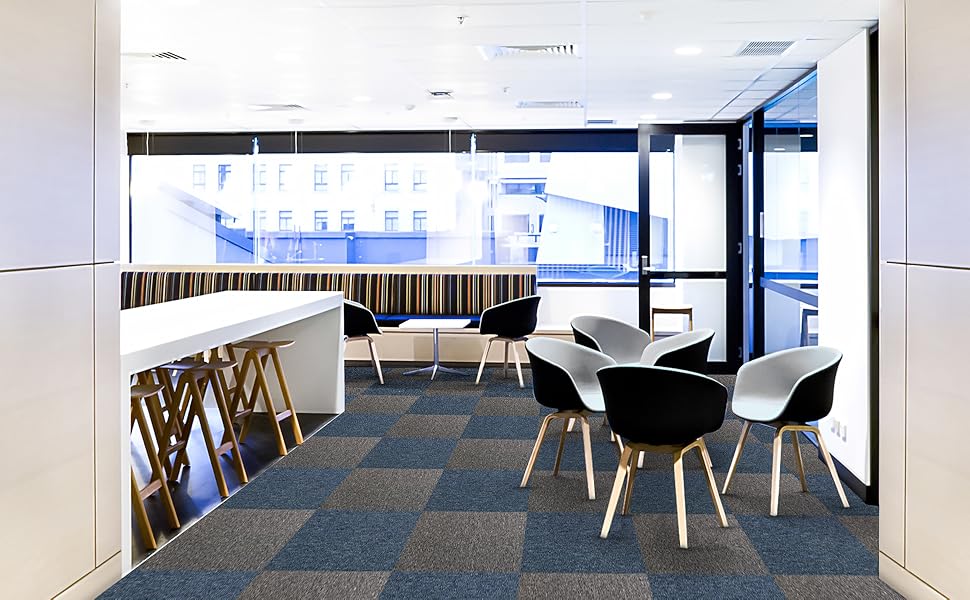Carpet tiles are a versatile and innovative flooring solution that caters to both residential and commercial spaces. For office environments, they provide a perfect blend of durability, style, and practicality. Designed to handle heavy foot traffic, reduce noise, and allow for easy maintenance, carpet tiles are an ideal choice for modern workspaces. Their modular design enables quick installation and cost-effective replacements, ensuring that your office stays professional and polished without breaking the bank.
In this guide, we’ll dive into the many benefits of carpet tiles, explore their uses in offices and commercial spaces, and share creative design ideas to elevate your workplace ambience.
What are carpet tiles?
Carpet tiles, also known as carpet squares or modular carpets, are pre-cut sections of carpet typically shaped as squares, although other shapes like planks are also available. Standard sizes range from 50 x 50cm to 96 x 96cm, and they often come with a built-in backing that includes cushioning and adhesive. This modular design makes them easy to handle, install, and maintain. Carpet tiles are available in a wide variety of colours, textures, and patterns, offering significant flexibility for creating customised flooring solutions. They are commonly made from materials like nylon, polyester, or natural fibres, depending on the intended application.
What are carpet tiles used for?
Carpet tiles are a versatile flooring solution, suitable for both residential and commercial settings. In homes, they are often used in living rooms, basements, and playrooms due to their comfort and practicality. For commercial spaces, they are favoured in offices, retail stores, and schools, thanks to their durability and ability to withstand heavy foot traffic. Carpet tiles are also popular in hospitals and other high-maintenance environments where ease of cleaning is critical. Additionally, their modularity makes them an excellent choice for temporary flooring, such as in trade shows or exhibitions, and for creative DIY projects that require customisable designs.
Are carpet tiles cheaper than carpet?
The cost of carpet tiles can be competitive when compared to traditional broadloom carpet, particularly when considering installation and maintenance. Carpet tiles are often DIY-friendly, reducing labour costs associated with professional installation. The ability to replace individual tiles rather than an entire carpet makes carpet tiles more cost-effective in the long run, especially in high-traffic or damage-prone areas.
Are carpet tiles good for home use?
Carpet tiles are an excellent option for home use, offering both practicality and aesthetic appeal. They allow for creative design possibilities, enabling homeowners to mix and match colours or patterns to suit their décor. Carpet tiles are easy to maintain, as damaged or stained tiles can be replaced individually without the need to overhaul an entire floor. Additionally, certain types of carpet tiles are moisture-resistant, which is ideal for basements or other areas prone to dampness. Their insulating properties add warmth and comfort to any room.
Are carpet tiles easy to install?
Yes, carpet tiles are designed for easy installation, making them a popular choice for DIY projects. To install them, start by cleaning and levelling the subfloor, then lay out the tiles in the desired pattern. Many carpet tiles feature a peel-and-stick backing for simple adhesion, while others may require double-sided carpet tape or additional adhesive. Tiles are easy to cut to fit corners and edges using a utility knife, ensuring a precise fit. With minimal tools required, such as a ruler and measuring tape, homeowners can quickly achieve professional-looking results without hiring an installer.
Can carpet tiles be used on stairs?
Carpet tiles can be used on stairs, but their application requires careful installation to ensure safety and durability. They are a practical option for stairs because individual tiles can be replaced if worn or damaged, and they allow for creative design opportunities. However, strong adhesive or double-sided tape is essential to keep the tiles securely in place. Additionally, stair nosing or edge trims may be needed to cover the edges of the tiles and provide a finished appearance. With proper installation, carpet tiles on stairs can offer both style and functionality while maintaining a safe, slip-resistant surface.
Arranging your carpet tiles
There are many ways to arrange these tiles, by alternating between two different colours or shades you can create a classic checkerboard effect. These designs work great in offices, kitchens, or playrooms.
Mix and match tiles in different colours or patterns for a whimsical, eclectic look. Choose complementary colours to avoid visual chaos and create a cohesive yet playful design. This style is ideal for children’s playrooms or creative workspaces.
Use carpet planks or tiles in alternating colours to create stripes across the room. Vertical stripes can elongate a space, while horizontal stripes can make a room appear wider. This design can be subtle with neutral tones or bold with bright colours.
At Monster Shop we have a range of carpet tiles in many colours and configurations that suit any space. Take a look here!

